RUSSIA
Economy

Economy

Cities in RUSSIA
| Moscow | Saint-petersburg |
Economy
General
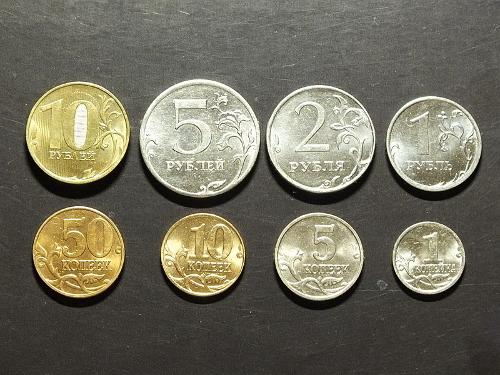 Russian Ruble coinsPhoto: Brateevsky CC 3.0 Unported no changes made
Russian Ruble coinsPhoto: Brateevsky CC 3.0 Unported no changes made
After the collapse of the Soviet Union at the end of 1991, the Russian Federation took over a chaotic economy on January 1, 1992. That economy was characterized by, among other things, enormous inflation and bankruptcy vis-à-vis other countries.
In order to face the severe economic crisis, the Yeltsin government (notably Finance Minister Gajdar) launched a radical policy of liberalization. They wanted to liberalize prices, drastically limit the budget deficit and reach an arrangement with foreign creditors and the IMF. In the long term, the government wanted to create an OECD-type economic system and also become a member of the EU. The results of the new policy were mixed, but were generally not easy.
The price liberalization was successful, but led to hyperinflation in the first years. Limiting the budget deficit turned out to be very difficult, mainly due to the poor tax morality of both citizens and companies. Privatization of the many state and collective companies met with great resistance because many cities were completely dependent on that one industrial complex that they had within the city limits. Its inevitable closure or downsizing would sweep away the economic base beneath such a city and was therefore usually thwarted by local administrators and their representatives at higher levels.
1997 saw the first signs of an economic recovery: GDP grew by 1.5%, industrial production increased by more than 2% and inflation remained 'limited' to 16% as a result of strict monetary policy (2004 11%). Annoyingly, the Communist-nationalist-dominated Duma often held back economic reforms: tax reform and privatization, for example, barely got off the ground. In August 1998 the Russian government could no longer meet its financial obligations; the country was in fact bankrupt. The ruble was devalued and the IMF and other international financial institutions provided emergency aid.
After 1998 the economy slowly recovered, partly due to the low exchange rate of the ruble, which led to an increase in exports. This was beneficial because the large stocks of raw materials form the cork on which the economy floats. However, this one-sided dependence makes the economy very vulnerable to price fluctuations on the world market.
Russia is now one of the world's leading producers of oil and natural gas and is also a top exporter of metals such as steel and aluminum. The economy grew by an average of 7% during the years 1998-2008 as a result of oil prices rising rapidly. However, the economy was badly hit by the global economic crisis of 2008-09 when oil prices plummeted and foreign credit dried up. In the fall of 2013, the Ministry of Economic Development reduced its growth forecast through 2030 to an average of just 2.5% per year, down from the previous forecast of 4.0 to 4.2%. In 2014, after Russia's military intervention in Ukraine, the outlook for economic growth continued to decline. The growth slowed to 1.5% in 2017.
More than 60% of the labor force works in the public and service sectors. The registered unemployment rate was 5.2% in 2017; however, there is a suspicion of large hidden unemployment.
Agriculture, livestock, fishing and forestry
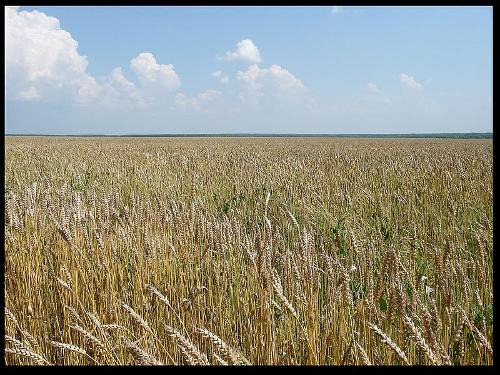 Grain is the most important agricultural product of RussiaPhoto: Essenseio CC 3.0 Unported no changes made
Grain is the most important agricultural product of RussiaPhoto: Essenseio CC 3.0 Unported no changes made
Approx. 32% of Russia's territory can only be used for agriculture, as much of the land is permanently frozen or polluted. Most agriculture is therefore concentrated in the south and in the west of Siberia. Despite the increasing growth in production, especially grain, the Russian agricultural sector cannot meet domestic demand and imports are necessary.
About 9.4% of the labor force is employed in the agricultural sector; together they supply 4.7% of the gross domestic product (2017).
The situation in agriculture after the collapse of the Soviet Union in 1991 was very problematic. Revenues fell, food was scarce and even rationed in many places. The situation was so worrisome that the mighty country was heavily dependent on food imports. The government agreed to a sweeping plan of agrarian reform, transforming the former state-owned companies into individual private companies, corporations or genuine cooperatives.
By meeting the desires and interests of the rural population, it was hoped to quickly change the former communist agricultural system. All state and collective companies have now been decollectivized.
Meat, egg and milk production has increased in recent years, despite a decline in livestock. The aim is to become self-sufficient in all these products.
Fishing is still an important economic sector for Russia, despite a sharp decline since the 1980s. The country supplies a significant part of the world production of fresh and frozen fish and approximately canned fish. Kamchatka, a peninsula in Eastern Siberia on the Bering Sea, is important to the fishing industry. Fish consumption per capita in Russia is about 23 kg per year.
Forestry is an important sector for the Russian economy. The country has the largest forests (770 million hectares, 45% of the surface) in the world, but timber extraction is very inefficient.
Industry
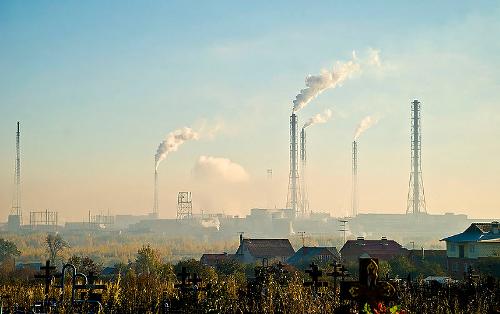 Industry RussiaPhoto: Alt-n-Anela CC 2.0 Generic no changes made
Industry RussiaPhoto: Alt-n-Anela CC 2.0 Generic no changes made
GENERAL
The industrial capacity of the former Soviet Union was very unbalanced, mainly focused on the extraction of raw minerals, the production of steel and weapons. The manufacturing of consumer goods was clearly second to none.
In the Gorbachev period, the military industry was converted into a consumer industry. This revolutionary turn was accelerated at the time of the Russian Federation.
Industry employed 27.6% of the labor force in 2017 and provided 32.4% of GDP; in 1990 this was still almost 50%. The main industrial areas are the industrial center around Moscow and Nizhny Novgorod, and the Ural region around Ekaterinburg, Chelyabinsk and Magnitogorsk.
MACHINE INDUSTRY
After the collapse of the Soviet Union, the production of machines fell significantly. In recent years, this sector has grown again due to the increasing demand for machines. However, domestic production cannot cope with the demand and therefore many machines are imported. Another reason for buying machines abroad is the relatively low quality level of the machines produced in Russia.
CAR INDUSTRY
To increase sales and production for most Russian car manufacturers, joint ventures with foreign companies seem the best solution. Ford, Renault, Daewoo, Fiat and Skoda have already entered the Russian market; others will soon follow, it is expected.
The largest car manufacturer of passenger cars in Russia is AvtoVAZ. This Togliatti-based company makes about 70% of all Russian cars. Other major car manufacturers are GAZ, Moskvich and the truck manufacturers UAZ and KamAZ.
Parts factories are usually located near car factories or are part of the company itself.
CHEMICAL INDUSTRY
In recent years, the chemical industry has been growing considerably. The cause is an increasing demand at home and abroad. The main products of the Russian chemical industry are basic chemicals. Other products include synthetic yarns, synthetic rubber, fiberglass, paints, varnishes and finished products for the agricultural, transport, health and construction sectors.
The internal market for polymers, in particular polyethylene and PVC and polypropylene, is new for Russia, but very promising. The sale of all these products will mainly have to be done domestically.
FOOD AND SAVINGS INDUSTRY
This sector is one of the fastest growing sectors of the Russian economy in recent years.
Growth sectors are confectionery, fruit juices, beer and tobacco. The demand for vodka is declining considerably, while the wine consumption is increasing by 30% annually.
The fast food market grew by 8% in the years 2000-2004. McDonalds opened its 109th branch in Russia in 2004.
Mining and energy
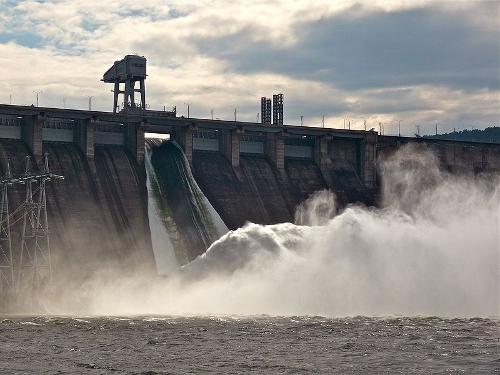 The Krasnoyarsk Dam in RussiaPhoto: Alex Polezhaev CC 2.0 Generic no changes made
The Krasnoyarsk Dam in RussiaPhoto: Alex Polezhaev CC 2.0 Generic no changes made
The gigantic Russia has enormous energy reserves and other valuable mineral reserves. These enormous stocks have made Russia one of the largest producers and exporters in the world. Russia has the largest gas reserves in the world, the second largest coal reserves and enormous oil reserves.
The largest stocks are in the northwest (Kola), the Far East, Siberia and the Urals. The main minerals are iron ore and coal (Cusbas Basin and Altai region), bauxite (Komi republic), gas, oil, coal, uranium, gold, chromium, silver, platinum, diamond, nickel cobalt, magnesium, manganese, lead and tungsten. Many of these minerals unfortunately do not meet Western quality standards. Only the nickel and aluminum sector meets these standards. The main export products in mining are currently aluminum, nickel, copper and iron.
The Russian mineral market is in the hands of a small number of mega-companies, which often control a large part of the world production.
Russia has more than 400 thermal and hydroelectric power plants and several dozen often outdated nuclear power plants, all located in the European part of Russia. In the coming years they also want to build a few more nuclear reactors.
The hydropower of the Volga and Angara rivers in Russia is harnessed by some of the largest hydropower plants in the world. Most of the energy in Russia comes from oil and nuclear power plants.
Concern for the environment has not kept pace with the growth of the mining and blast furnace industries. Especially in the Urals and Siberia the landscape has been completely destroyed and polluted in some places. For example, the current natural gas network contains various fractures and cracks, polluting rivers and soil.
In many Russian cities, the concentration of harmful substances in the air has reached a value that far exceeds Western standards. Drinking water is also highly polluted in many cities. The gigantic dams in the Volga, Dnepr, Dnestr, Don and Kuban threaten the ecological balance in these regions.
Trade
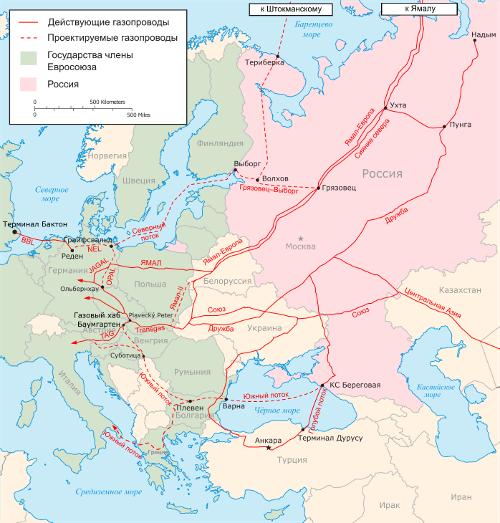 Major russian gas pipelines to europePhoto: Nzeemin CC 4.0 International no changes made
Major russian gas pipelines to europePhoto: Nzeemin CC 4.0 International no changes made
When the Russian Federation became independent, the foreign market was still mainly in the hands of state organizations and companies. The then government wanted to liberalize foreign trade while skimming off most of the revenues generated by the oil, gas and forestry sectors for the benefit of the central government. Export taxes apply to a number of raw materials, so that a portion is always retained for domestic use.
Russia's main export partners are the European Union, and within it mainly Germany and the Netherlands; also China, the United States, Turkey and Belarus.
Russia mainly exports electricity, oil, natural gas, coal, ores, timber and timber products. The total value of exports in 2017 was $ 353 billion.
Many food (products) are imported, as well as machine (parts), vehicles and pharmaceutical products. The main import partners are China, Germany, Japan, United States and the countries of the EU. The total value of the imports was $ 3238 billion in 2013. Russia thus has a large trade surplus.
Traffic
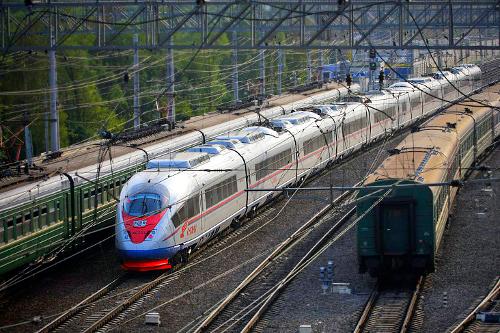 Russian high-speed trainPhoto: Mika Stetsovski CC 4.0 International no changes made
Russian high-speed trainPhoto: Mika Stetsovski CC 4.0 International no changes made
The Russian road network has a total length of over 1,000,000 km. The main roads connect Moscow and Saint Petersburg with cities such as Minsk, Nizhny Novgorod, Yaroslavl, Simferopol and Samara.
For the modernization of the road network, the Russian government has drawn up a program that will have to be implemented in two phases. Actual implementation started in 2006. At the moment they are still busy with the implementation.
The poor condition of the road network is the reason that less than 15% of total freight transport is by road.
The total length of the railway network is 150,000, of which 86,300 km is used for passenger trains; the other lines are for industrial transport. The Russian railways are responsible for most of the national freight traffic.
The Trans-Siberian Railway connects Moscow with Vladivostok on the Sea of Japan. The main lines in the Urals and in Western Siberia are electrified. The second, economically very important, major railway through Siberia, the Baikal-Amur Railway (BAM), connects Tajshet with Komsomolsk.
The waterways have a total length of 106,000 km. The busiest rivers are the Volga, the Don, the Ob, the Lena and the Amur.
Main ports are Saint Petersburg, Kaliningrad exclave, Moscow, Arkhangelsk, Novorossijsk, Nizhny Novgorod and Vladivostok; Petropavlovsk (on the Kamchatka peninsula), Nakhodka (east of Vladivostok) and Makhachkala (on the Caspian Sea) are gaining importance as ports. Russia has a total of 43 seaports. More than 70% of all Russian-European freight is handled through ports on the Gulf of Finland.
Russian territory is covered by a dense network of flight paths. Moscow is the center for national and international air traffic with four airports, of which Domodedovo is the largest and most modern.
Saint Petersburg, Omsk and Vladivostok also have international airports. In total, Russia has more than 500 airports.
The largest airline is Aeroflot. There are also about 200 other airlines, which often do not own more than a few aircraft.
Sources
Graaf, A. van der / Reis-handboek Sovjet-Unie
Elmar
Rusland, Centraal-Azië en de Kaukasus
The Reader’s Digest,
Russia & Belarus
Lonely Planet
Te gast in Rusland
Informatie Verre Reizen
CIA - World Factbook
BBC - Country Profiles
Copyright: Team The World of Info